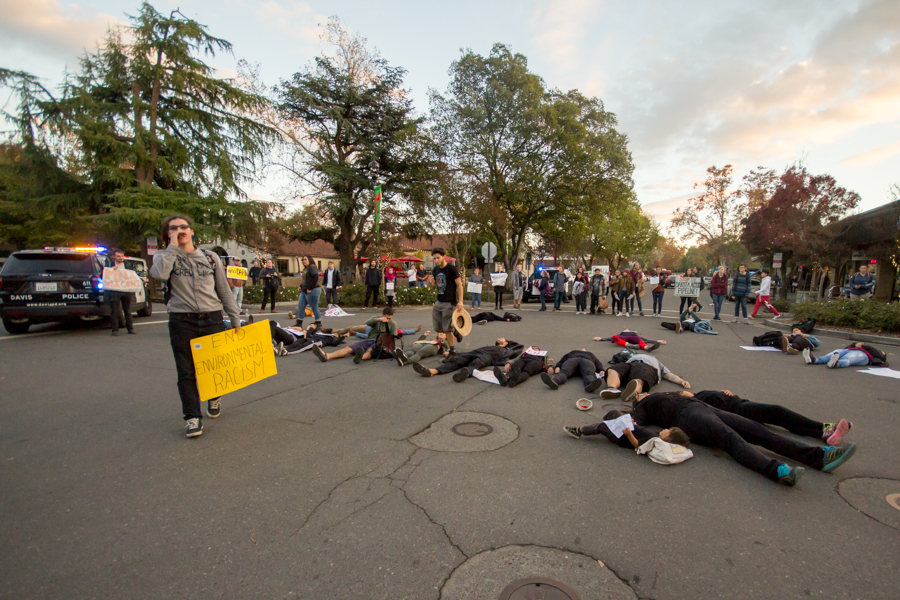
Students, activists call for solidarity with Standing Rock
As blue and red police lights wailed through the air in downtown Davis, dozens laid at the intersection of 2nd Street in Downtown Davis in protest. Chants calling for action against the Dakota Access Pipeline (DAPL) invaded the unsettling stillness of the bodies. Thus, on Nov. 21, Davis became one of many cities across the country to support with the Standing Rock Sioux tribe.
Water is sacred; water is life — this is the repeated phrase of the Standing Rock Tribe in North Dakota, which for months has adamantly protested the installation of an oil pipeline. The tribe claims that the pipeline not only violates native land rights, but that it also threatens the local drinking water supply.
The pipeline itself is planned to run across four states, but it is the part of the pipeline’s journey across the Missouri River in particular that has caused protests to erupt across the country.
Francisco Ferraya, a third-year transfer community and regional development major and organizer of the downtown Davis NoDAPL protest, argued that the DAPL is not just a matter of access to clean drinking water, but an issue of civil rights for Native Americans.
“[This pipeline] represents more than just another fossil fuel contract,” Ferraya said. “This is really the culmination of 500 years of cultural genocide and historical erasure. It’s the most important battle right now, I think, against capitalism, against American imperialism and against fossil fuels.”
The DAPL was previously planned to be routed just north of Bismarck, N.D. but was rerouted after the U.S. Army Corps of Engineers deemed its planned location a potential contaminant to Bismarck’s water supply.
Now, Standing Rock faces a similar dilemma, but with a different response.
“[The protesters] were attacked [a few] nights ago, with a super high-powered hose in like, 20-degree weather, and pepper spray and mace,” Ferraya said.
Ferraya is no stranger to the violence surrounding NoDAPL protests, having recently been to North Dakota to join the Standing Rock tribe.
“I went about a week after the video surfaced where the water protectors were attacked by dogs,” Ferraya said. “It was really powerful because folks were there just days after the dogs had attacked them, so I saw the wounds with my own eyes.”
The protest in downtown Davis was one of many across the country, including a recent protest in Sacramento.
According to the official Stand with Standing Rock website, “The Oceti Sakowin Camp represents a first of its kind historic gathering of Indigenous Nations. The most recent such assembly of Tribes occurred when the Great Sioux Nation gathered before the Battle at the Little Big Horn.”
Energy Transfer Partners (ETP), the company in charge of the development and implementation of the DAPL, recently engaged in a merger with Sunoco Logistics, another pipeline operating company. ETP is anxious to carry on with the project.
“Dakota Access has been waiting long enough to complete this pipeline,” said Kelcy Warren, the chief executive officer of ETP, in a previous interview.
Davis City Council previously passed a resolution stating that it supports with Standing Rock. Resolution 16-XXX, Series 2016 cites both the environmental tragedy that such a pipeline would pose and the adverse effects the pipeline would pose on the Standing Rock Sioux tribe:
“Now, therefore, be it resolved that the City Council of the City of Davis, stands in support of the opposition to the Dakota Access Pipeline process and project and calls on all residents of Davis to raise awareness about this important struggle for Indigenous sovereignty and environmental justice and to support the Sacred Stones Camp’s efforts.”
Written by: Samantha Solomon — city@theaggie.org


